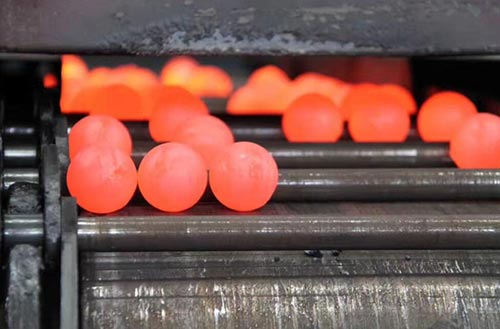What is the heat treatment of grinding balls?
Views: 977 Update Date:Aug 19 , 2024
Heat treatment of grinding balls is a crucial process that enhances their performance and longevity. Here's a general overview:
Process: The balls are heated to a high temperature (typically between 800°C to 1000°C) where they become fully austenitic.
Process: The balls are quickly cooled, usually in water or oil. This rapid cooling transforms the austenite into martensite, a hard and brittle phase.
Process: The balls are reheated to a lower temperature (typically between 150°C to 200°C) and held at this temperature for a specific period, then cooled down slowly.
Improved Toughness: Reduces the likelihood of breakage and chipping.
Uniform Properties: Ensures consistent performance during grinding operations.
Heat treatment parameters can vary depending on the specific material composition of the grinding balls and the requirements of the grinding application.
Prev: What are the applications of ball milling?
Next: What are mill balls used for?
1. Austenitizing
Purpose: To transform the microstructure of the grinding balls into austenite, which is a face-centered cubic phase of iron that allows for better hardening.Process: The balls are heated to a high temperature (typically between 800°C to 1000°C) where they become fully austenitic.
2. Quenching
Purpose: To rapidly cool the grinding balls to set the austenitic structure into a hardened phase.Process: The balls are quickly cooled, usually in water or oil. This rapid cooling transforms the austenite into martensite, a hard and brittle phase.
3. Tempering
Purpose: To reduce the brittleness of the martensitic structure and improve the toughness and ductility of the grinding balls.Process: The balls are reheated to a lower temperature (typically between 150°C to 200°C) and held at this temperature for a specific period, then cooled down slowly.
4. Normalizing (optional)
Purpose: To refine the grain structure and improve uniformity of the mechanical properties.Process: The balls are heated to a temperature above the critical point and then air-cooled.

Key Benefits of Heat Treatment:
Increased Hardness: Enhances wear resistance and extends the service life of the grinding balls.Improved Toughness: Reduces the likelihood of breakage and chipping.
Uniform Properties: Ensures consistent performance during grinding operations.
Heat treatment parameters can vary depending on the specific material composition of the grinding balls and the requirements of the grinding application.





